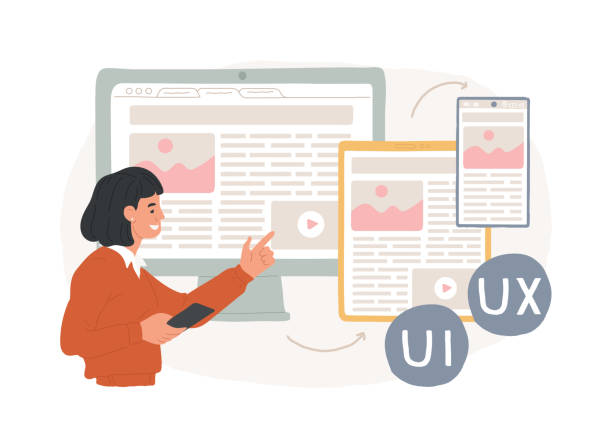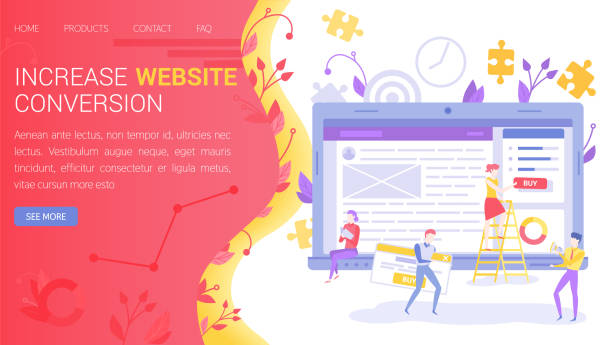Introduction to the Importance of Secure Website Design in the Digital World

In today’s world, where physical boundaries hold less meaning and many daily activities have shifted to the internet, secure website design is no longer an option, but an unavoidable necessity.
Websites are not only showcases for businesses and platforms for providing information, but often serve as a place for exchanging sensitive user data, including financial, personal, and identity information.
Neglecting #website_security can lead to #data_breaches, loss of user trust, damage to brand reputation, and even irreparable financial losses.
Given the increasing complexity of cyber attacks and the tools used by hackers, a #comprehensive_approach in design and development must be prioritized.
This field requires a combination of #technical expertise, practical #guidance, and continuous #threat_analysis to create a strong defensive shield against potential dangers.
The importance of this issue is such that many organizations and businesses consider secure website design as one of the main pillars of their digital strategy.
This introduction is the beginning of a deeper journey into the world of online platform protection.
Does your company’s website create a professional and lasting first impression on potential customers? Rasawb, with its professional corporate website design, not only represents your brand’s credibility but also opens a path for your business growth.
✅ Create a powerful and trustworthy brand image
✅ Attract target customers and increase sales
⚡ Get free consultation
Familiarity with the Most Common Website Security Threats

To achieve secure website design, the first step is a precise and comprehensive understanding of the most common threats targeting websites.
These threats can range from simple phishing attacks to complex advanced cyber intrusions.
One of the most common types of attacks is SQL Injection, which allows an attacker to gain access to the database by inserting malicious code into site inputs, thereby altering or stealing information.
Another threat is XSS attacks (Cross-Site Scripting), where malicious client-side code (usually JavaScript) is injected into visitors’ browsers and can lead to the theft of cookies or session information.
Furthermore, CSRF (Cross-Site Request Forgery) attacks, which trick users into sending unwanted requests to trusted websites, are serious concerns in ensuring online security.
DoS/DDoS attacks, aimed at making a website unavailable by sending a massive volume of malicious traffic, can disrupt the performance and access of legitimate users.
This section analytically examines these threats and how to identify them to pave the way for implementing secure website design measures.
Secure Coding Standards and Best Practices

The heart of secure website design is adhering to secure coding standards.
Developers play a vital role in creating a robust online platform.
This section expertly and guidance-oriented examines the most important coding approaches and techniques that prevent common vulnerabilities.
One fundamental principle is Input Validation; all data received from the user, whether form fields, URL parameters, or HTTP headers, must be carefully checked and sanitized to prevent the injection of malicious code.
Using Prepared Statements when working with databases is essential to combat SQL Injection attacks.
Also, strong encryption for passwords instead of storing them in plain text, and using secure hashing algorithms like bcrypt or Argon2, are other vital principles.
Proper session management, including generating random session IDs, short session lifetimes, and invalidating sessions after user logout, significantly helps increase security.
Not displaying detailed and technical errors to users (Error Handling) and logging them on the server is also essential to prevent the disclosure of sensitive system information.
Below is a useful table for programmers, which serves as an educational guide:
| Vulnerability | Brief Description | Prevention Methods |
|---|---|---|
| SQL Injection | Injecting malicious SQL codes for unauthorized database access. | Using Prepared Statements, strict input validation. |
| Cross-Site Scripting (XSS) | Injecting malicious scripts into web pages to run in the user’s browser. | Proper Output Encoding, using Content Security Policy (CSP). |
| Cross-Site Request Forgery (CSRF) | Tricking the user into performing unwanted requests to the server. | Using CSRF tokens, checking Origin Header. |
| Broken Authentication and Session Management | Flaws in authentication or session management systems. | Using strong hashing algorithms for passwords, secure session management (HTTPS, HttpOnly, Secure). |
| Insecure Deserialization | Insecure processing of serialized data that can lead to remote code execution. | Not deserializing untrusted data, monitoring exceptions. |
The Role of Server and Infrastructure Security in Website Hardening

Secure website design is not limited to coding; server and infrastructure security are also of paramount importance.
No matter how secure a website’s code is, if it runs on an insecure server, it will be highly vulnerable.
This section explanatorily and expertly covers key aspects of server security.
Proper configuration of Firewalls to filter incoming and outgoing traffic and block unnecessary ports is the first line of defense.
The use of Intrusion Detection Systems (IDS) and Intrusion Prevention Systems (IPS) to identify and prevent suspicious activities can actively protect the server.
Additionally, regular updates of the operating system, web server (such as Apache or Nginx), database (such as MySQL or PostgreSQL), and other software used are highly important, as many attacks occur through known vulnerabilities in older software versions.
Managing access and user accounts on the server must also be done carefully; using user accounts with the least privilege and disabling default accounts reduces the risk of unauthorized access.
Full disk encryption of the server and regular, secure data backups are other essential measures for securing the web platform at the infrastructure level.
Are you tired of your e-commerce website having visitors but no sales? Rasawb solves your main problem with professional e-commerce website design!
✅ Significant sales increase with targeted design
✅ Seamless user experience for your customers
⚡ Get free consultation!
Data Protection and User Privacy

One of the most important aspects of secure website design is protecting user data and ensuring their privacy.
With increasing concerns about data breaches, websites are obligated to address this issue with utmost seriousness.
This section educates and explains the importance and methods of data protection.
Using the HTTPS protocol (with a valid SSL/TLS certificate) to encrypt all communications between the user’s browser and the website server is a fundamental necessity.
This prevents eavesdropping on data in transit by attackers.
Sensitive user data, such as passwords, credit card information, and personal details, must be stored in the database in an encrypted format and using strong algorithms.
In addition to encryption, restricting access to sensitive data only to authorized individuals and systems (based on the principle of least privilege) is crucial.
Websites must be aware of and comply with data privacy laws, such as GDPR in Europe or CCPA in California.
Transparent privacy policies, which explain to users what data is collected, how it is used, and with whom it is shared, are essential for building trust.
Finally, educating employees about the importance of data protection and adhering to internal security protocols also plays a significant role in ensuring website security.
User Authentication and Access Management

Authentication and access management systems are the backbone of any secure website design.
Weaknesses in this area can easily lead to unauthorized access and security breaches.
This section provides guidance and education on best practices in this field.
Using strong passwords that are a combination of uppercase and lowercase letters, numbers, and symbols is the first step.
Additionally, enforcing policies such as periodic password changes and preventing password reuse increases security.
Implementing Two-Factor Authentication (2FA) or Multi-Factor Authentication (MFA) for users adds a powerful security layer, even if their password is compromised.
These methods can include sending codes to mobile phones, using authentication apps, or hardware security keys.
Role-Based Access Control (RBAC), which means granting necessary and sufficient access to each user based on their role and duties, is another important principle in website security.
For example, a regular user should not have access to administrative functions or the database.
Monitoring logins and suspicious activities, such as repeated unsuccessful login attempts, can help identify Brute-Force attacks or intrusion attempts.
Implementing CAPTCHA can also play an effective role in preventing bot and Brute-Force attacks.
Regular Security Reviews and Essential Updates

A critical aspect of maintaining secure website design is conducting regular security reviews and applying continuous updates.
Cyber threats are constantly evolving, so website defenses must be updated in sync with them.
This section informatively and analytically addresses the importance of these processes.
Vulnerability Scanning helps identify known weaknesses in the system.
These scans can be performed automatically with tools like Nessus or OpenVAS.
In addition to automated scanning, Penetration Testing, performed by security specialists (known as ethical hackers), manually attempts to discover and exploit vulnerabilities, just like a real attacker.
This approach helps identify more complex and logical vulnerabilities that might be overlooked by automated scanners.
Furthermore, ensuring continuous updates of all software used, including the server operating system, web server, Content Management System (CMS) like WordPress or Joomla, plugins, and programming libraries, is crucial.
Many successful attacks target known vulnerabilities that can be resolved with a simple update.
Following security advisories and news announcements from software vendors helps you stay informed about the latest threats and security patches.
These proactive approaches are an integral part of secure web development.
| Tool/Approach Name | Primary Use | Further Description |
|---|---|---|
| WAF (Web Application Firewall) | Protection against common web application attacks (SQLi, XSS, etc.). | Filtering HTTP traffic, preventing Layer 7 attacks. |
| SSL/TLS Certificates | Encrypting communication between browser and server. | Establishing HTTPS, ensuring data confidentiality and integrity. |
| Vulnerability Scanners | Automated identification of known vulnerabilities. | Tools such as Acunetix, Nessus, OpenVAS. |
| Penetration Testing (Pentesting) | Manual penetration testing by experts to discover hidden vulnerabilities. | Simulating real attacks, providing detailed reports. |
| Security Information and Event Management (SIEM) | Collecting, analyzing, and correlating security logs. | Identifying attack patterns, real-time alerting. |
Security Incident Management and Disaster Recovery Plan

Even with the best secure website design approaches, the likelihood of security incidents never drops to zero.
Therefore, having a well-defined plan for Incident Response and Disaster Recovery is of paramount importance.
This section provides guidance and explanation on the importance of these plans.
The incident management plan includes the stages of identification, containment, eradication, recovery, and lessons learned from a cyber attack.
The security team must know exactly who is responsible for what in the event of a breach or attack, and there must be clear steps for quick response.
This helps minimize damage and reduce service downtime.
Also, regular and secure backup of data and code is a fundamental principle in the disaster recovery plan.
These backups must be stored in separate, secure locations and be capable of quick and complete recovery.
The disaster recovery plan goes beyond simple backup and includes processes for restoring systems and data to operational status after a major event (such as a large-scale DDoS attack, hardware failure, or natural disaster).
Periodic testing of these plans (e.g., simulating attacks) is essential to ensure their effectiveness and to train teams for quick response.
These preparations not only help protect the web during a crisis but also increase user trust and preserve business credibility.
Are you worried your old company website is scaring off new customers? Rasawb solves this problem with modern and efficient corporate website design.
✅ Increases your brand’s credibility.
✅ Helps attract target customers.
⚡ Contact Rasawb for a free consultation!
The Human Factor in Website Security

While the focus might entirely be on the technical aspects of secure website design, the human factor should not be overlooked.
Many successful cyberattacks occur not through technical system flaws, but by tricking individuals (social engineering).
This section, with an entertaining and thought-provoking content approach, examines this crucial aspect.
Did you know that the easiest way to infiltrate a large organization might start with a cunning phishing email and a single wrong click by an employee? Educating employees at all levels of the organization, from managers to support staff, about basic cybersecurity principles, recognizing phishing attacks, identifying suspicious emails, and practicing personal cyber hygiene, is an unparalleled investment for website security.
Training topics should include creating strong passwords, avoiding password reuse, recognizing suspicious links, the importance of locking the screen when away from the system, and vigilance against phone calls or emails requesting sensitive information.
Furthermore, encouraging the reporting of suspicious activities and fostering a culture where individuals learn from their mistakes rather than being blamed helps create a safer environment.
Because no matter how robust a firewall is, if the main entrance is opened by an unaware employee, it loses its effectiveness. This section aims to engage the reader’s mind with thought-provoking content on the importance of education and awareness in security.
Compliance with International Security Laws and Standards

Along with technological advancements, numerous international laws and standards have been developed for secure website design and data protection.
Adherence to these regulations is not only a legal requirement but also helps increase user trust and your business’s legitimacy.
This section explains and specializes in some of the most important ones.
The European Union’s General Data Protection Regulation (GDPR) is one of the most comprehensive and stringent data privacy laws in the world.
Any website that processes the information of EU citizens, regardless of its server location, is required to comply with GDPR.
This includes rights such as the right to access data, the right to be forgotten, and the right to data portability.
The California Consumer Privacy Act (CCPA) is another example of such laws, providing similar rights for California citizens.
In addition to privacy laws, industry security standards like the Payment Card Industry Data Security Standard (PCI DSS) are essential for any website that processes, stores, or transmits payment card information.
Non-compliance with these standards can lead to severe penalties and loss of card processing capability.
Adhering to these frameworks not only strengthens website security but also demonstrates the organization’s commitment to protecting user and customer information.
These regulations help create an expert and legal perspective for securing the web platform.
Frequently Asked Questions
| Question | Answer |
|---|---|
| 1. What does secure website design mean? | Secure website design means creating a website that is resilient against cyber attacks and protects user and server information. |
| 2. Why is security important in website design? | To prevent data breaches, protect user privacy, maintain user trust, and avoid financial and reputational losses. |
| 3. What are the most common web vulnerabilities? | SQL Injection, Cross-Site Scripting (XSS), Cross-Site Request Forgery (CSRF), Broken Authentication, and Security Misconfiguration. |
| 4. How can SQL Injection be prevented? | By using Prepared Statements / Parameterized Queries, ORMs, and Input Validation. |
| 5. What is the role of HTTPS and SSL/TLS in site security? | HTTPS uses the SSL/TLS protocol to encrypt communication between the user’s browser and the server, preventing eavesdropping and data tampering. |
| 6. What measures should be taken to prevent XSS attacks? | Input validation, Output Encoding to prevent malicious code execution, and using Content Security Policy (CSP). |
| 7. What does a strong password policy include? | Enforcing the use of long passwords, a combination of uppercase and lowercase letters, numbers, and special characters, and preventing reuse. |
| 8. How does Two-Factor Authentication (2FA) help security? | Even if the user’s password is compromised, the attacker cannot access the account without access to the second authentication factor (such as an SMS code or app). |
| 9. What is a Web Application Firewall (WAF) and what is its use? | A WAF is a firewall that monitors and filters HTTP traffic between a web application and the internet to prevent common web attacks like SQL Injection and XSS. |
| 10. Why are regular software and library updates important? | Updates often include security patches to address discovered vulnerabilities. Failure to update can expose the site to new attacks. |
And other services of Rasa Web Advertising Agency in the field of advertising
Smart Link Building: An innovative service to increase user engagement through intelligent data analysis.
Smart Direct Marketing: Designed for businesses seeking to increase click-through rates through SEO-driven content strategy.
Smart Link Building: A combination of creativity and technology for campaign management through precise audience targeting.
Smart Website Development: A professional solution for user interaction with a focus on SEO-driven content strategy.
Smart Marketing Automation: An effective tool for digital branding by utilizing real data.
And over hundreds of other services in the field of internet advertising, advertising consulting, and organizational solutions
Internet Advertising | Advertising Strategy | Advertorial
Resources
- Secure Website Design Guide – IranHost
- New Web Security Challenges – Rayvarz
- New Security Threats in Website Design – BartarinSite
- Comprehensive Website Security Guide – ParsData
? Rasaweb Afarin, a specialist in digital marketing solutions, helps your business achieve its goals. We are your best partner for success in the digital world in the areas of WordPress website design, SEO optimization, social media management, and online advertising campaigns. Contact us today for a free consultation and to learn about our services!
📍 Tehran, Mirdamad Street, next to Central Bank, Southern Kazeroun Alley, Ramin Alley, No. 6




